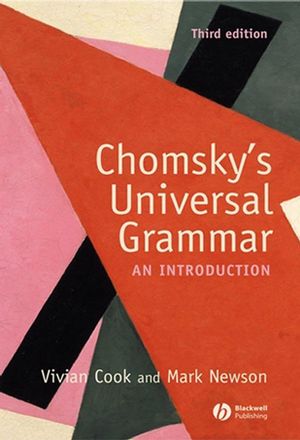Chomsky's Universal Grammar: An Introduction, 3rd EditionISBN: 978-1-4051-1186-7
Hardcover
336 pages
May 2007, Wiley-Blackwell
 This is a Print-on-Demand title. It will be printed specifically to fill your order. Please allow an additional 10-15 days delivery time. The book is not returnable.
Other Available Formats: Paperback
|
||||||
1. The Nature of Universal Grammar.
1.1. The Early Development of Universal Grammar Theory.
1.2. Relating 'Sounds' and 'Meanings'.
1.3. The Computational System.
1.4. Questions for Linguistics.
1.5. General Ideas of Language.
1.6. Linguistic Universals.
1.7. The Evidence for Universal Grammar Theory.
1.8. Conclusion.
2. Principles, Parameters and Language Acquisition.
2.1. Principles and Parameters.
2.2. Language Acquisition.
3. Structure in the Government/Binding model.
3.1. The Heart of the Government/Binding Model.
3.2. Modules, Principles and Parameters.
3.3. X-bar Theory in Government and Binding.
3.4. Theta Theory.
3.5. Control Theory and Null Subjects.
3.6. Further Developments in X-bar Theory.
3.7. Summary.
4. Movement in Government/Binding Theory.
4.1. An Overview of Movement.
4.2. Further Developments to the Theory of Movement.
4.3. Bounding, Barriers and Relativized Minimality.
4.4. Case Theory.
4.5. Binding Theory.
4.6. Beyond S-structure and the Empty Category Principle.
5. Chomskyan Approaches to Language Acquisition.
5.1. The Physical Basis for Universal Grammar.
5.2. A Language Learning Model.
5.3. The Innateness Hypothesis.
5.4. The Role of Universal Grammar in Learning.
5.5. Complete from the Beginning or Developing with Time?.
5.6. Issues in Parameter Setting.
5.7. Markedness and Language Development.
6. Second Language Acquisition and Universal Grammar.
6.1. The Purity of the Monolingual Argument.
6.2. Universal Bilingualism.
6.3. The Multi-competence View.
6.4. The Poverty-of-the-stimulus Argument and Second Language Acquisition.
6.5. Models and Metaphors.
6.6. Hypotheses of the Initial Second Language State.
6.7. The Final State of Second Language Acquisition.
7. Structure in the Minimalist Program.
7.1. From Government/Binding to the Minimalist Program.
7.2. Basic Minimalist Concepts.
7.3. Phrase Structure in the Minimalist Program.
7.4. Thematic Roles and Structural Positions.
7.5. Adjunction.
7.6. Linear Order.
8. Movement in the Minimalist Program.
8.1. Functional Heads and Projections.
8.2. The Motivation for Movement.
8.3. The Nature of Movement.
8.4. Overt and Covert Movement.
8.5. Properties of Movement.
8.6. Phases.
8.7. Conclusion.
References.
Index



